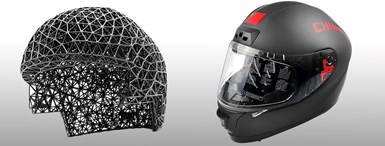3D Printed Bobsled Helmet Improves Safety, Lowers Weight
Additive manufacturing enabled researchers to develop custom-fit bobsled helmets with lattice linings that increased impact resistance and lowered weight.

The 3D printed bobsled helmet lining on the left includes custom lattices for individual wearers, distributed to shore up frequent impact zones while reducing helmet weight by almost a third. The helmet at the right is the full version used for racing. Image courtesy of Farsoon Technologies.
Bobsled racing involves steering down a narrow, downhill track of ice-covered twists, turns and straight-aways. Racers can reach 160 kilometers per hour, and as such, need sturdy protective gear. Associate professor Li Nan of Dongguan University of Technology recently headed an R&D team including Farsoon Technologies and Wanhua Chemical Group to develop full-face bobsled helmets for use in the 2022 Beijing Winter Olympic Games.
“Compared to traditional manufacturing, 3D printing offers us more possibilities for design optimization and customization,” Li says, pointing to additive manufacturing’s potential for higher mechanical strength, reduced weight and personalized fit.
Optimal Performance Through Open Partnerships
Li and the Wanhua and Farsoon application teams leveraged the open parameters of Farsoon machines to test various parameter combinations of laser power, scan spacing and layer thickness. After extensive testing, Wanhua Chemical developed a specialized TPU material, and the team optimized its processing parameters to balance the helmet lining lattice structure’s mechanical performance and weight requirements.
"Our material achieved good elasticity and flexibility down to -35°C and solved technical challenges with laser absorption and powder re-coating for TPU material processing,” says Dr. Yang Jie, strategy R&D manager of Wanhua Chemical.
The team used Farsoon’s dual fiber-laser Flight 403P printer, which offers industrial-scale manufacturing with TPU materials. It uses dual 300-watt fiber lasers and dynamic optical systems to create two ultra-fine laser spots with scanning speeds of up to 20 meters per second (66 feet per second). With a build volume of 400 × 400 × 450 mm, the team could produce two helmet linings in a single, 7.5-hour build.
Custom Lattices Enhance Protection
The team relies on 3D scanning to customize each helmet lining to best fit each athlete’s head, rather than rely on standard helmets’ limited sizes and fittings. This lattice structure is composed of multiple layers and buffer zones with different hardness levels. Impact zones with higher collision frequencies receive greater support to accurately absorb the damage caused in head collisions.
The 3D printed lattice lining and carbon fiber shell weigh only 1.1 kilograms – 500 grams less than traditional foam helmets. Li also reports that the impact strength of the helmet is over 40% higher than the international standard.
Related Content
-
3D Printed Cutting Tool for Large Transmission Part: The Cool Parts Show Bonus
A boring tool that was once 30 kg challenged the performance of the machining center using it. The replacement tool is 11.5 kg, and more efficient as well, thanks to generative design.
-
Seurat: Speed Is How AM Competes Against Machining, Casting, Forging
“We don’t ask for DFAM first,” says CEO. A new Boston-area additive manufacturing factory will deliver high-volume metal part production at unit costs beating conventional processes.
-
This 3D Printed Part Makes IndyCar Racing Safer: The Cool Parts Show #67
The top frame is a newer addition to Indycar vehicles, but one that has dramatically improved the safety of the sport. We look at the original component and its next generation in this episode of The Cool Parts Show.














